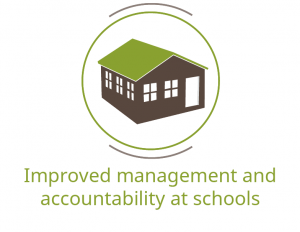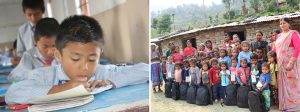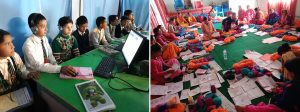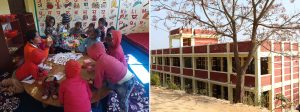Children enjoy the right to quality education
Over the years, investment in the education sector has risen substantially. To enhance equitable access to education at all levels, policy, program, and institutional reform measures have been adopted. As a result, the number of children enrolled in the first grade with early childhood development experience is 66.9%5. Net Enrolment Rate (NER) at the primary level (1-5 grade) and basic (1-8 grade) had reached 96.9% and 92.7% respectively. The promotion rate stands at 82.4% in grade 1 and 92.6% in grade 5. The proportion of pupils reaching grade eight is 79.3%, while the gross enrolment in secondary education (grades 9-10) is 60.6%. The ratio of girls and boys having basic education (grades 1-8) has just reached parity, and the NER in secondary levels stand at 88.9% respectively. Literacy rate among 15-24 years age group was 88.6% in 2015 and reached 92% in 2019 (Flash Report 2019/2020).
Despite these improvements in education, the overall academic performance of children is unsatisfactory. 20% of basic level students in Nepali and 32% in mathematics subjects have below average performance7. The learning achievement scores in major subjects like maths, English, and Nepali is 35%, 48%, and 41% respectively does not meet School Sector Reform Plan targets. Additionally, in the basic level 240,641 children are still out of school (Flash Report 2019/2020).
Highly encouraging are increasing enrolment rates. Conversely, necessary conditions need to be made so that students complete secondary education (grade 12) and children from disadvantaged groups are identified, enrolled, and retained at school. Education quality is another issue that public schools in Nepal are grappling with and addressing it requires sustained efforts from all concerned.
Outcomes |
||
 |
 |
 |
Improved access to and quality of education
In the past two decades, Nepal has made significant progress in creating access to education. However, there are many challenges in access and quality of education. Inequity in access persists due to socioeconomic, geographic, and ethnic factors. Key barriers in children’s enrolment and regular attendance are consequences of poverty, social exclusion, disability, migration, social norms, and gender bias. As the anticipated targets have not been achieved, the primary focus should be on ensuring access and quality.

Interventions
- Construction/renovation of school infrastructure
- Teaching-learning packages (science lab, library, furniture, computer lab, etc.) support
- Child-friendly classroom management
- Education materials for children
- Capacity building of teachers/facilitators on pedagogical practices
- ICT integration in education (SMART Classroom)
- Focused early grade reading interventions and extra-/co-curricular activities (E/CCA)
Improved school management and accountability
In Nepal, education policies and plans assume key roles and responsibilities of school stakeholders, parents in particular in school governance. Sensitizing school stakeholders of their roles and responsibilities and facilitating cooperation amongst themselves can potentially contribute to improving the governance of a public school.
However, in the new federal setup, many local governments are yet to formulate context-based policies and plans that suit their students. Sociocultural status and limited formal education have been shown to lead to lowered/less frequent engagement of parents in school management. As a result, school management and governance mechanisms are yet to be synchronized with national education policies, plans, and programs.
Interventions that are targeted at school management committees/parent-teacher associations (SMCs/PTAs), head teachers, and local government (LG) focal persons will sensitize them on policy and provisions of school management and accountability and their capacity will be developed for introducing specific provisions. Parental education, awareness-raising, and community mobilization for school activities will support in bridging the gap between community and school. Focused assistance to LGs for formulating an education plan will be provided which is expected to promote and prioritize access to and quality of public school education through continuous engagement of stakeholders in education management. Action research on ICT-based education among GNI partner schools will generate knowledge for replicating the model on a wider scale.
 Interventions
Interventions
- Develop capacity of SMCs/PTAs, headteachers, and focal persons
- Introduce special mechanisms
- Parental education, awareness-raising, and counseling
- Support local government units in formulating local-level education plans
- Action research on ICT-based education and results dissemination
Enhanced resilience of schools
In Nepal, many schools are vulnerable to disasters, as their physical infrastructures do not meet safety standards. Nepal is implementing the Safe School Policy 2019 and Comprehensive School Safety Minimum Package 2019. Raising awareness of students, incorporation of disaster risk reduction (DRR) and school safety in the curriculum, floods, landslides, and earthquakes, and related preparedness, safe infrastructure, capacity building, retrofitting, maintenance, etc. have been included as disaster mitigation measures.
A resilient school is one that can absorb disturbances, changes, reorganize, and still retain the same basic structures and provide the same services to the students and community. GNI Nepal will support partner schools in strengthening their institutional capacity to adapt and implement school safety measures including making physical infrastructure resilient.
Risk assessment will provide a detailed picture of schools as regards their vulnerability towards disasters and hazards. Based on it, a school safety plan can be drawn and resource allocation and necessary action can be taken. GNI Nepal will facilitate the construction and renovation of school infrastructure meeting national resilient school standards. For capacity building on school safety and preparing municipal level DRR and school safety action plans, local governments’ engagement and collaboration will be actively sought.

Interventions
- Multi-hazard risk assessment of schools
- Formulate school safety plans
- Retrofit/construct resilient school infrastructure
- Facilitate the preparation and implementation of municipal-level school safety plans
- Collaborate with LGs to promote school safety practices
- Orient parents and local stakeholders on school safety Develop and disseminate awareness-raising materials on school safety